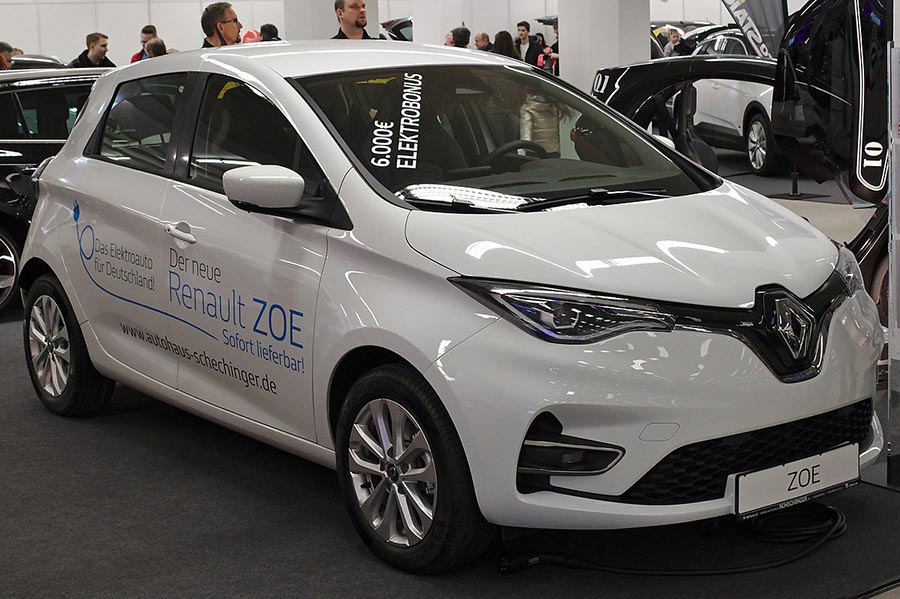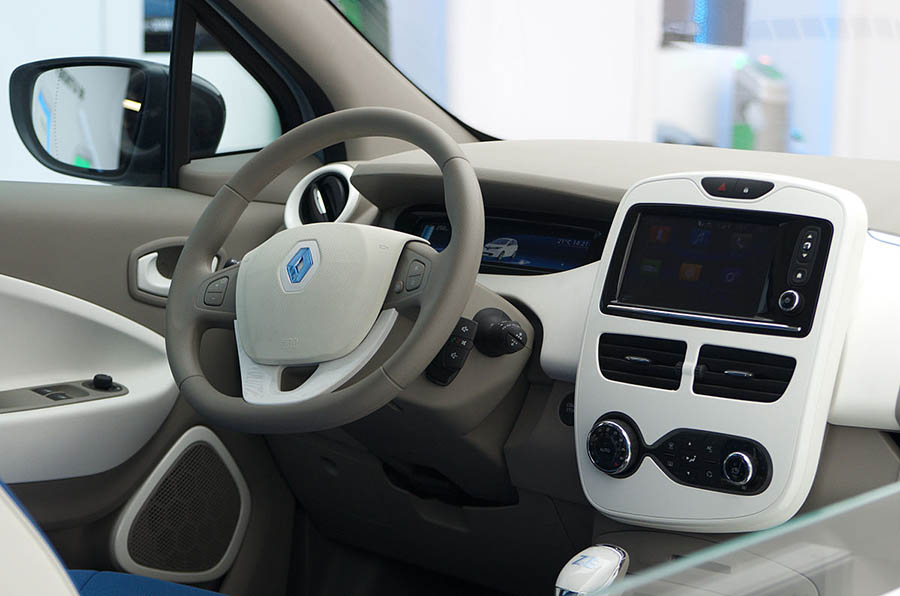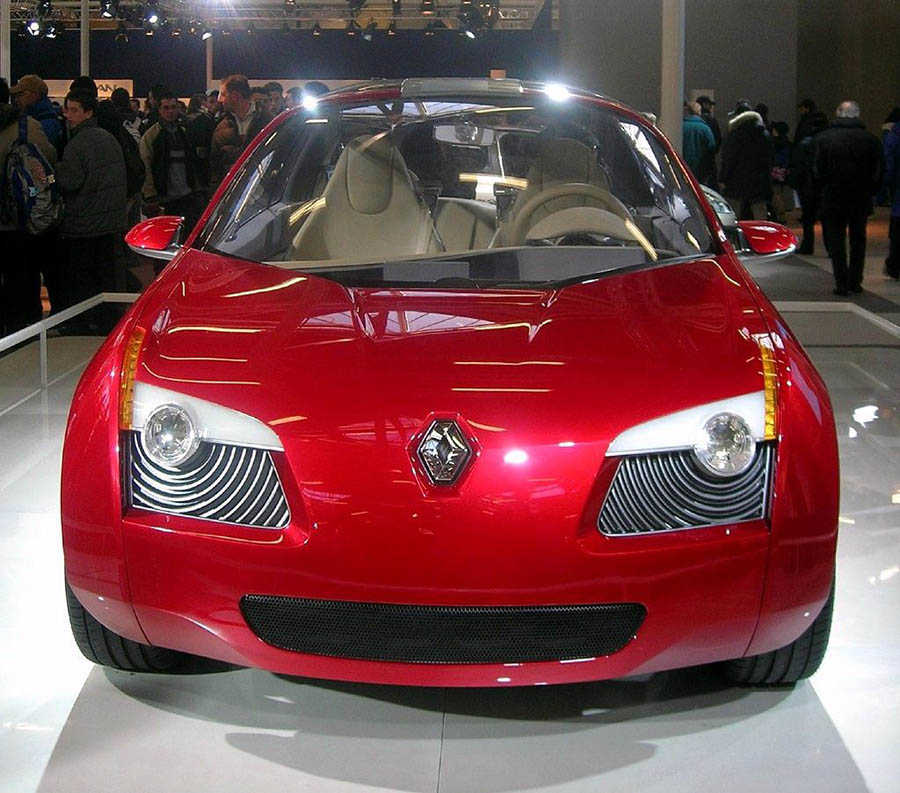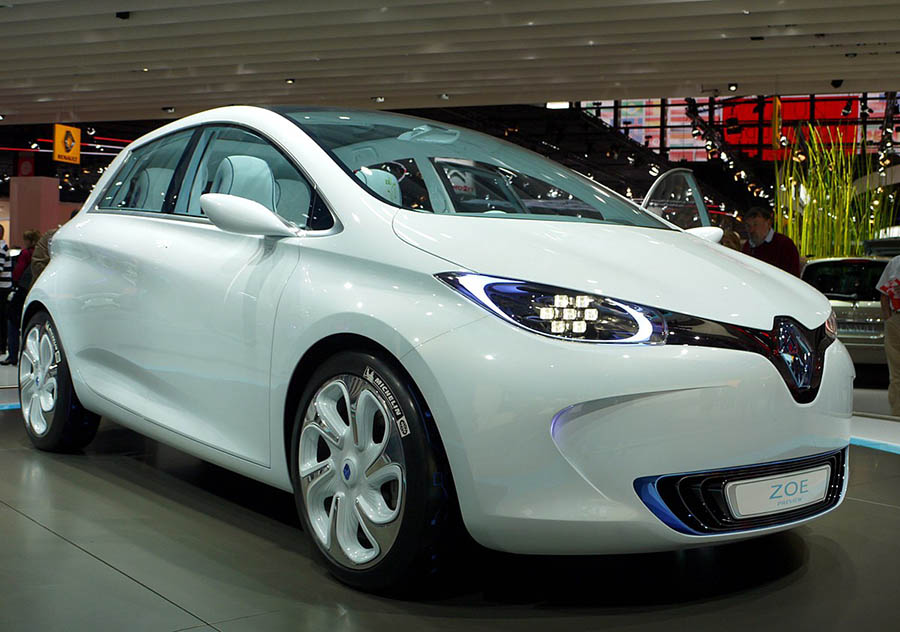The Renault ZOE is an electrically powered small car from the French manufacturer Renault, which has been delivered since March 2013. The ZOE is on the same platform as the vehicle Renault Clio and, like the latter, manufactured in Flins.

Presentation
The official launch of the ZOE (Q210) took place on March 18, 2013 in Paris, the next week Renault in France began delivering it. At that time, sales contracts for the ZOE were also concluded in Germany and Austria, and delivery began here in June 2013.
In spring 2015, the ZOE version R240 was introduced, the engine drive train of which was developed and manufactured by Renault. Compared to the previous version Q210, whose drive train comes from the supplier Continental, the new charging system only supports quick charging on the three-phase AC network up to a maximum of 22 kW, compared to 43 kW of the Continental engine, but has 30 km more range in the NEDC. The R-Link Evolution multimedia system has been expanded and now supports Android Auto.
Drive Technology
The ZOE has an externally excited synchronous motor with a nominal output of 43 kW. It reaches a limited top speed of 135 km / h. The scope of the series Q210 with 22-kWh battery is 210 kilometers (NEDC), the practical range here was the manufacturer between 100 and 150 km away. The range of the R240 series of 240 km (NEDC). Since January 2017, the NEDC-homologated range of the 41 kWh battery available since then has been 400 km.

Renault itself is next to 300 km effective under practical conditions as mentioned on its sales website. Test reports also show that even under extreme conditions such as winter outside temperature, switched on heating, lights and other devices, driving on the motorway (however, a maximum of 100 km / h), driving uphill, etc., an actually driven range of approx. 270 km is possible.

Charging system and energy storage
All versions of the Renault ZOE have the so-called Chameleon Charger ex works. The integrated charger enables the batteries with different outputs between 3.7 and 43 kW AC to be charged via a charging connection. With (called ZE 40) the battery upgrade to 41 kWh sold in Germany mainly the engine version R110 (Renault motor), which allows a maximum charging output of 22 kW. Individual dealers also offer the combination of a Q90 engine and a 41 kWh battery.

Until the model variant R110, which was released in 2018, all ZOE variants were only supplied with a type 2 charging plug in the front. With the R110, it was possible for the first time to obtain a CCS type 2 charging plug for an additional charge, in which the charging process is carried out with direct current instead of alternating or three-phase current. 43 kW for type 2 and 50 kW for CCS type 2 plugs are mainly available on common, commercial charging stations with quick charging function. CCS plugs on charging stations with higher charging power can be used mechanically and electrically, but the vehicle actually limits the power used to 50 kW.
According to the manufacturer, the charging times for the 41 kWh drive battery are:
- at a 43 kW charging station approx. 1:05 for 80%,
- on a 22 kW wallbox approx. 1:38 for 80% and 2:40 for 100%,
- on an 11 kW wall box (3 × 16 A) approx. 3:20 for 80% and four and a half hours for 100%,
- on a 3.1 kW connection (1 × 14 A) around 13 hours for 80% and 16 hours for 100% as well
- on a 2.3 kW connection (1 × 10 A) around 20 hours for 80% and 25 hours for 100% of the capacity.
The drive accumulator of the ZOE was originally to be supplied by the cooperation partner Nissan and received the same cells as the Nissan Leaf. In July 2012, it was announced that contrary to the original plans, the drive battery would be manufactured by the South Korean LG Chem. This change made changes to the system software necessary, which delayed the start of series production.
Possible combinations motor / battery
The vehicle is differentiated based on the engine variants and the energy storage capacity, with Q standing for Quick (quick charging system) and R standing for Range.
Q210: This version has the original Continental engine. The chameleon system charges the battery with a charging capacity of up to 43 kW. It can absorb 21 kWh, which means that the vehicle will travel 210 km in the New European Driving Cycle (NEDC).
R240: This version has the electric motor developed by Renault itself. The maximum charging power is 22 kW, the range of the 21 kWh battery increases to 240 km in the NEDC due to the somewhat more economical engine.
R75: This variant is only available on the French market under the name “Life”.
R90: Here the Renault engine is combined with 22 kW charging electronics and the larger 41 kWh battery.
Q90: With the introduction of the 41 kWh battery, the Continental engine could be used together with the larger battery. Although the variant was only offered sporadically in Germany, Q210 owners could get this combination through a battery upgrade.
R110: Version with 80 kW motor and optionally 41 kWh battery or 52 kWh battery.
R135: Version with 100 kW motor and optionally 41 kWh battery or 52 kWh battery.
Battery on rent
Originally, it was only possible in Germany to rent the battery for a monthly fee of currently between 69 and 119 euros (as of 03/2018) depending on the annual mileage. There is now an option to buy the battery for a one-time surcharge of 8,000 euros (as of 03/2018).
In the first few years (except Norway), the Renault ZOE was only offered in combination with a rental contract for the battery. The rental agreement also includes an assistance service, which guarantees that a car that has stopped due to insufficient battery charge is transported free of charge to the next charging station. The monthly rent is 69 euros for the large 41 kWh battery with a mileage of up to 7500 km / year and increases with a higher annual mileage. The smaller 21 kWh battery has a 10 euro lower rent. A lower entry price can be realized through the battery rental.

At the beginning of the first wave of sales, a German newspaper claimed that, in the event of serious and repeated violations of this rental agreement, for example due to unpaid monthly installments, Renault was able to deactivate the battery charging function by remote access. The vehicle would then have to drive to an authorized workshop, or be taken where this restriction can be deleted from the software.
Selling as a used car becomes a little more complicated due to the necessary battery rental, since the battery rental contract has to be rewritten. However, the advantage of selling is that the buyer has no battery risk. If the capacity falls below 75%, it will be replaced by Renault. Since December 2016, the battery of the Renault Zoe can also be purchased on request.
Concepts
Concept car with a gasoline engine (2005)
The first concept was a small car, introduced in 2005, with a length of 3.45 m. Unlike the planned series version, the 2005 concept was not powered electrically, but by a 1.2-liter petrol engine with 73 kW. This developed a maximum torque of 145 Nm. The power was transferred to the front wheels. The five gears were shifted using the shift paddles on the steering wheel.

Concept car with electric drive (2009)
At the IAA 2009, an electric concept car called Renault Zoé ZE Concept was presented. The vehicle is powered by an electric motor with 54 kW power and has scissor doors.

Close to production version (2010)
The third concept was presented in 2010 as the Renault Zoé Preview. Visually, it largely corresponded to the production vehicle.

Sales
The Renault Zoe is the best-selling electric car in Europe, with a total of more than 200,000 units sold (as of January 2020). With 9,431 units, the Zoe was also the best-selling electric car in Germany in 2019.

In May 2016 the 50,000th Renault Zoe was delivered, in March 2018, the 100,000th unit was produced. In November 2019, the mark of 200,000 vehicles produced has been reached.
Renault only sells the Zoe in Europe (as of May 2020). In July 2018, 220 Renault Zoe were produced per day at Flins plant near Paris. Production was increased to 440 units per day by the end of 2018. Around 30,000 Renault Zoe were produced in 2017. An extensively revised version of the Zoe was introduced in autumn 2019.









